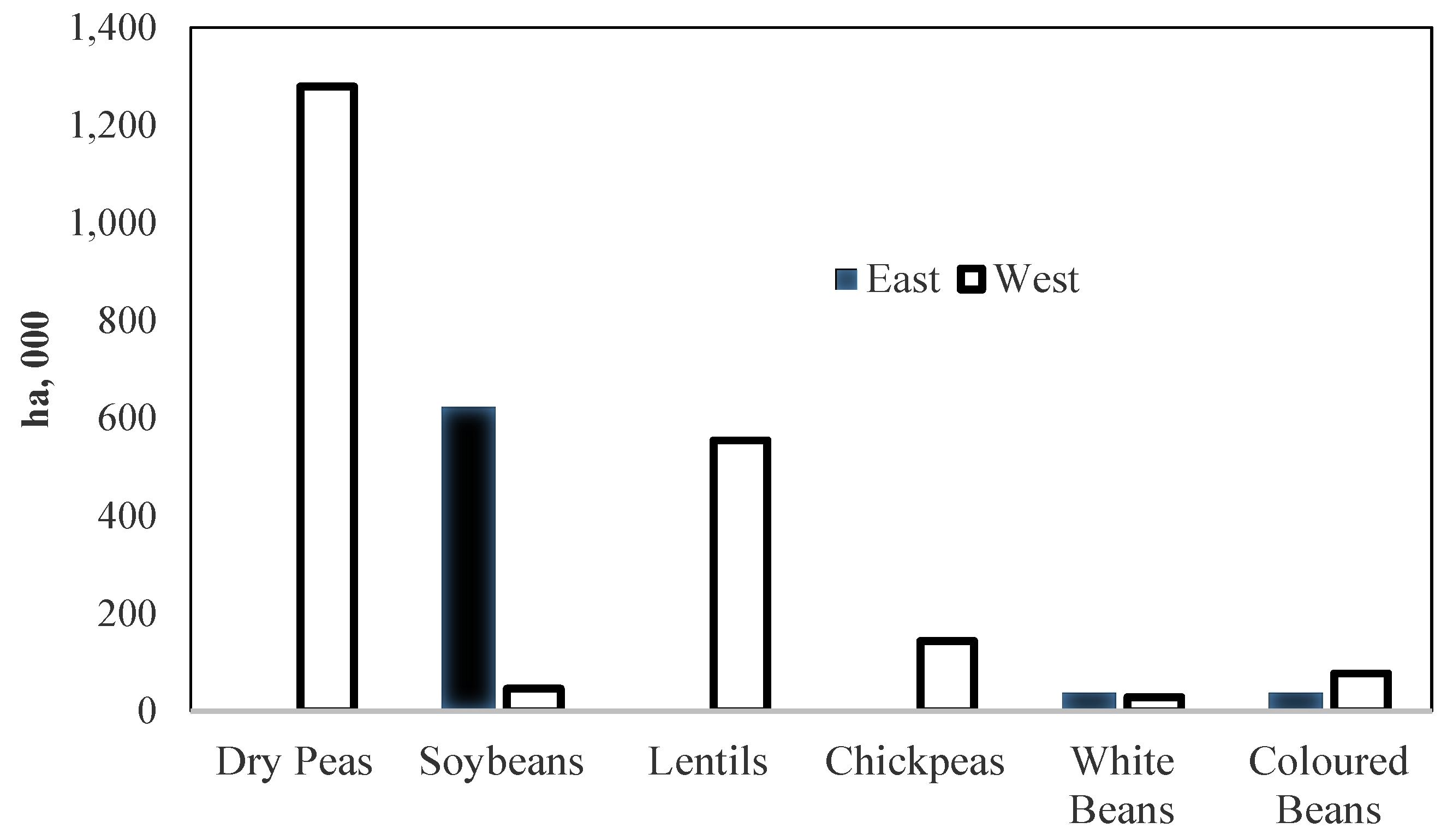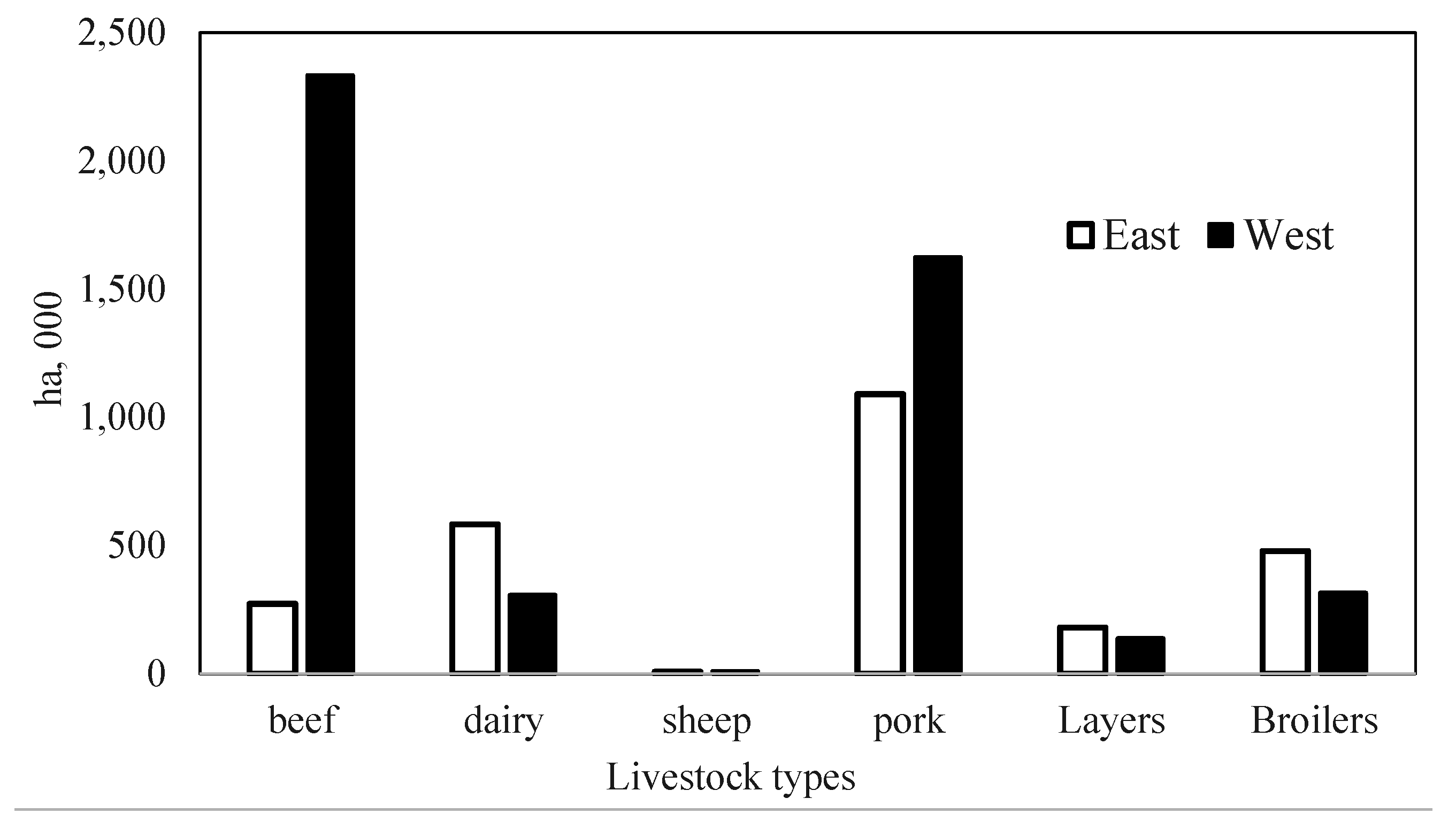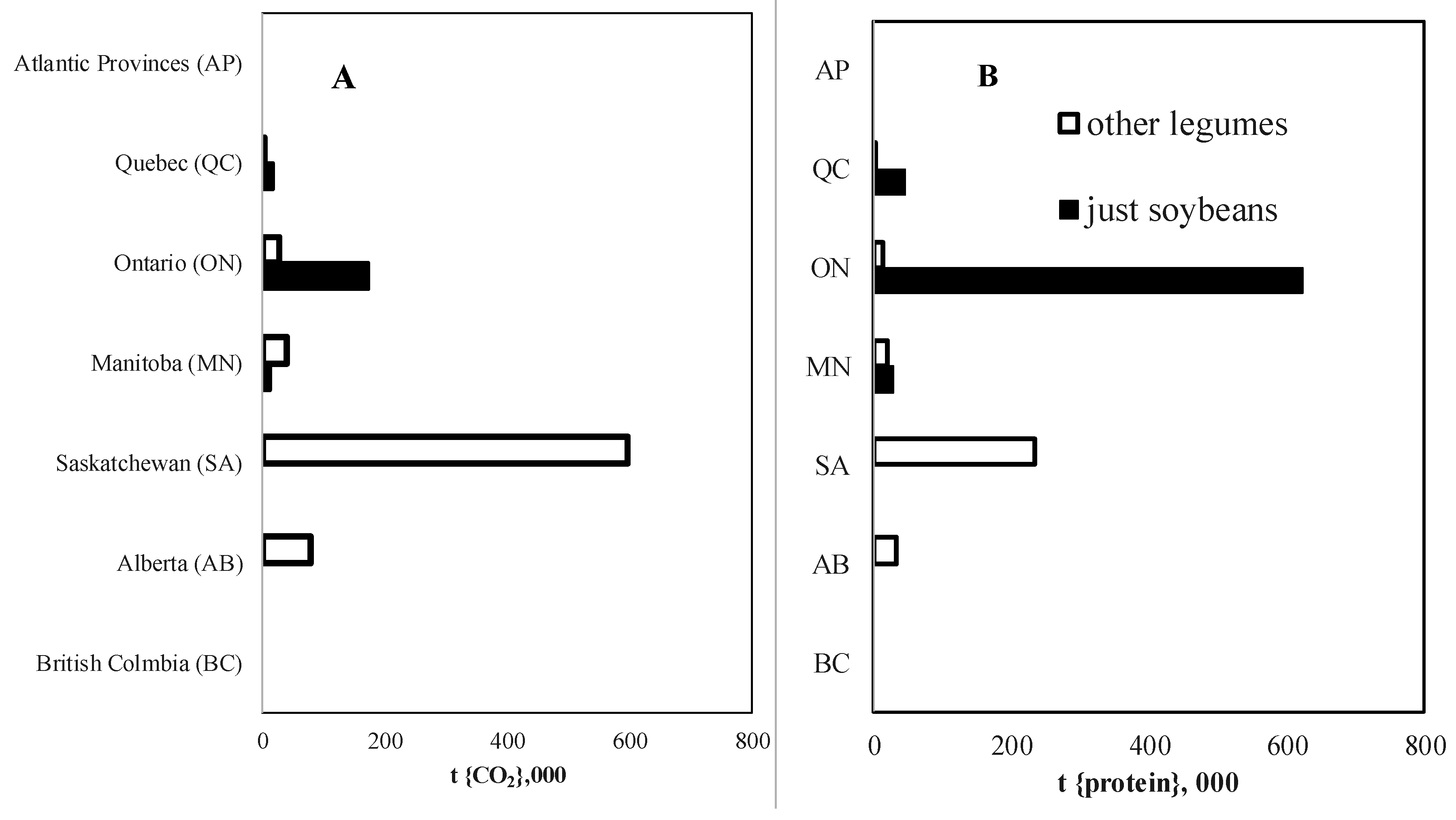The Role of Canadian Agriculture in Meeting Increased Global Protein Demand with Low Carbon Emitting Production
Abstract
:1. Introduction
2. Background
3. Materials and Methods
3.1. Selecting the Performance Indicators
3.2. Performance Modelling Methodology
3.3. Defining Protein Conversion Factors
| Plant Protein | Animal Protein | |||
|---|---|---|---|---|
| Pulse Crops | % of DM Yield | Livestock | % of LW | Kg(protein)/head |
| Dry peas | 7.7 | Beef | 8.3 | |
| Soybeans | 35.0 | Dairy | 237 | |
| Lentils | 9.0 | Sheep | 6.4 | |
| Chick peas | 8.9 | Pork | 9.8 | |
| White beans | 9.7 | Layers | 1.03 | |
| Coloured beans | 8.9 | Broilers | 10.1 | |
3.4. Defining the Area Inputs for Protein Production



4. Results
4.1. Area Inputs for Livestock and Pulse Protein Production
4.2. Livestock GHG Emissions and Protein Production
| CH4 | N2O | Fossil CO2 | All GHG | Protein | |
|---|---|---|---|---|---|
| Tg CO2eq | t,000 | ||||
| Eastern Canada | |||||
| Ruminants 1 | 7.57 | 4.04 | 1.46 | 13.07 | 226 |
| Non-ruminants 2 | 2.10 | 2.21 | 1.00 | 5.31 | 292 |
| All livestock | 9.67 | 6.25 | 2.46 | 18.38 | 518 |
| Western Canada | |||||
| Ruminants 1 | 19.41 | 8.50 | 2.14 | 30.06 | 274 |
| Non-ruminants 2 | 2.05 | 1.14 | 0.84 | 4.03 | 204 |
| All livestock | 21.47 | 9.64 | 2.98 | 34.09 | 478 |
| Canada | |||||
| Ruminants 1 | 26.98 | 12.54 | 3.60 | 43.12 | 500 |
| Non-ruminants 2 | 4.16 | 3.35 | 1.84 | 9.34 | 496 |
| All livestock | 31.14 | 15.89 | 5.44 | 52.46 | 996 |
4.3. Pulse GHG Emissions and Protein Production

4.4. Results of Three Indicators for Pulse and Protein Production
| Protein Sources: | tCO2/ha | Kg (protein)/ha | tCO2/t (protein) | |||
|---|---|---|---|---|---|---|
| Animal: | East | West | East | West | East | West |
| Ruminants | 15.17 | 11.33 | 263 | 103 | 57.77 | 109.83 |
| Non-ruminants | 3.13 | 1.82 | 167 | 83 | 18.79 | 21.97 |
| Plant: | East | West | East | West | East | West |
| Soybeans | 0.30 | 0.26 | 1077 | 630 | 0.28 | 0.42 |
| Other legumes | 0.41 | 0.34 | 207 | 139 | 1.98 | 2.46 |
| Provinces 3 | AP | QC | ON | MN | SA | AB | BC |
|---|---|---|---|---|---|---|---|
| Reporting units | |||||||
| Land 3 use intensity of GHG emissions | Indicator 1 | ||||||
| tCO2eq/ha | 9.3 | 7.8 | 4.4 | 5.2 | 3.4 | 6.7 | 13.0 |
| Land use intensity of protein production | Indicator 2 | ||||||
| T (protein)/ha | 0.23 | 0.27 | 0.42 | 0.15 | 0.12 | 0.09 | 0.32 |
| Protein-based intensity for GHG emissions | Indicator 3 | ||||||
| tCO2eq/t (protein) | 40.4 | 28.6 | 10.5 | 35.2 | 27.9 | 77.6 | 40.3 |
5. Discussion
5.1. Evaluating Indicator Performance
5.2. Implications for Protein Demand
6. Conclusions
Author Contributions
Conflicts of Interest
References
- Jacob, B. Global Hunger for Protein Fuels Food-Industry Deals. The Wall Street Journal. 11 June 2014. Available online: http://www.wsj.com/articles/global-hunger-for-protein-fuels-food-industry-deals-1402444464 (accessed on 31 August 2015).
- Kelly, T. Impending Crisis: Earth to Run Out of Food by 2050. Time. 7 December 2010. Available online: http://newsfeed.time.com/2010/12/07/impending-crisis-earth-to-run-out-of-food-by-2050/ (accessed on 31 August 2015).
- Ritter, K. Climate Change Could Push 100 Million into Extreme Poverty By 2030. The Associated Press. Available online: http://www.huffingtonpost.ca/2015/11/09/climate-change-100-million-poverty-world-bank_n_8509444.html (accessed 10 November 2015).
- Smith, P.; Haberl, H.; Popp, A.; Erb, K.-H.; Lauk, C.; Harper, R.; Tubiello, F.N.; de Siqueira, P.A.; Jafari, M.; Sohi, S.; et al. How much land-based greenhouse gas mitigation can be achieved without compromising food security and environmental goals? Glob. Chang. Biol. 2013, 19, 2285–2302. [Google Scholar] [CrossRef] [PubMed]
- Alexander, P.; Rounsevell, M.D.A.; Dislich, C.; Dodson, J.R.; Engström, K.; Moran, D. Drivers for global agricultural land use change: The nexus of diet, population, yield and bioenergy. Glob. Environ. Chang. 2015, 35, 138–147. [Google Scholar] [CrossRef]
- D’Odorico, P.; Carr, J.A.; Laio, F.; Ridolfi, L.; Vandoni, S. Feeding humanity through global food trade. Earth Future 2014, 2, 458–469. [Google Scholar] [CrossRef]
- Cheadle, B. Obama’s Climate-Change Talk Stands in Stark Contrast to Canadian Party Leaders. The Canadian Press. 1 September 2015. Available online: http://www.cbc.ca/news/world/obama-s-climate-change-talk-stands-in-stark-contrast-to-canadian-party-leaders-1.3211523 (accessed on 1 September 2015).
- Green, Low-Emission and Climate-Resilient Development Strategies (United Nations Development Programme (UNDP)). 2015. Available online: http://www.undp.org/content/undp/en/home/ourwork/environmentandenergy/focus_areas/climate_strategies.html (accessed on 31 August 2015).
- Gerber, P.J.; Steinfeld, H.; Henderson, B.; Mottet, A.; Opio, C.; Dijkman, J.; Falcucci, A.; Tempio, G. Tackling Climate Change Through Livestock—A Global Assessment of Emissions and Mitigation Opportunities; Food and Agriculture Organization of the United Nations (FAO): Rome, Italy, 2013; p. 139. [Google Scholar]
- Goodland, R. The Overlooked Climate Solution: Joint Action by Governments, Industry, and Consumers. J. Hum. Secur. 2010, 6. Available online: http://search.informit.com.au/documentSummary;dn=332506353716599;res=IELHSS (accessed on 6 November 2015). [Google Scholar] [CrossRef]
- Ripple, W.J.; Smith, P.; Haberl, H.; Montzka, S.A.; McAlpine, C.; Boucher, D.H. Ruminants, climate change and climate policy. Nat. Clim. Chang. Opin. Comment 2014, 4, 2–4. [Google Scholar] [CrossRef]
- The Role of Livestock in Climate Change. Available online: http://www.fao.org/agriculture/lead/themes0/climate/en/ (accessed on 31 August 2015).
- Dyer, J.A.; Vergé, X.P.C.; Desjardins, R.L.; Worth, D.E. The protein-based GHG emission intensity for livestock products in Canada. J. Sustain. Agric. 2010, 34, 618–629. [Google Scholar] [CrossRef]
- Whitbread, D. Top 10 Foods Highest in Protein You Can’t Miss. Health Alicious Ness. 2011. Available online: http://www.healthaliciousness.com/articles/foods-highest-in-protein.php (accessed on 21 August 2015).
- ChartsBin Statistics Collector Team (CBSCT). Daily Protein Intake Per Capita. Available online: http://chartsbin.com/view/1155 (accessed on 30 August 2015).
- Mack, S. How Many Amino Acids Does the Body Require? Living Strong. Last Updated February 2014. Available online: http://www.livestrong.com/article/463106-how-many-amino-acids-does-the-body-require/ (accessed on 30 August 2015).
- Understanding Our Bodies: Amino Acids Are Important. Available online: http://nutritionwonderland.com/2009/07/understanding-our-bodies-amino-acids/ (accessed on 30 August 2015).
- Whitbread, D. Beans and Legumes with the Most Protein. HealthAliciousNess. 2011. Available online: http://www.healthaliciousness.com/articles/beans-legumes-highest-protein.php#percent-protein (accessed on 21 August 2015).
- Dyer, J.A.; Vergé, X.P.C.; Desjardins, R.L.; Worth, D.E. A comparison of the greenhouse gas emissions from the sheep industry with beef production in Canada. Sustain. Agric. Res. 2014, 3, 65–75. [Google Scholar] [CrossRef]
- Vergé, X.P.C.; Dyer, J.A.; Worth, D.; Smith, W.N.; Desjardins, R.L.; McConkey, B.G. A greenhouse gas and soil carbon model for estimating the carbon footprint of livestock production in Canada. Animals 2012, 2, 437–454. [Google Scholar] [CrossRef] [PubMed]
- Vergé, X.P.C.; Dyer, J.A.; Desjardins, R.L.; Worth, D. Greenhouse gas emissions from the Canadian dairy industry during 2001. Agric. Syst. 2007, 94, 683–693. [Google Scholar] [CrossRef]
- Vergé, X.P.C.; Dyer, J.A.; Desjardins, R.L.; Worth, D. Greenhouse gas emissions from the Canadian beef industry. Agric. Syst. 2008, 98, 126–134. [Google Scholar] [CrossRef]
- Vergé, X.P.C.; Dyer, J.A.; Desjardins, R.L.; Worth, D. Greenhouse gas emissions from the Canadian pork industry. Livest. Sci. 2009, 121, 92–101. [Google Scholar] [CrossRef]
- Vergé, X.P.C.; Dyer, J.A.; Desjardins, R.L.; Worth, D. Long Term trends in greenhouse gas emissions from the Canadian poultry industry. J. Appl. Poult. Res. 2009, 18, 210–222. [Google Scholar] [CrossRef]
- McLaughlin, E.M.; Alain, B. Livestock Feed Requirements Study 1999–2001; Catalogue No. 23–501-XIE; Statistics Canada: Ottawa, ON, Canada, 2003. [Google Scholar]
- 2006 IPCC Guidelines for National Greenhouse Gas Inventories, Volume 4 Agriculture, Forestry and Other Land Use. Available online: http://www.ipcc-nggip.iges.or.jp/public/2006gl/vol4.html (accessed on 16 September 2015).
- Rochette, P.; Worth, D.E.; Lemke, R.L.; McConkey, B.G.; Pennock, D.J.; Wagner-Riddle, C.; Desjardins, R.L. Estimation of N2O emissions from agricultural soils in Canada. I. Development of a country-specific methodology. Can. J. Anim. Sci. 2008, 88, 1–14. [Google Scholar] [CrossRef]
- Dyer, J.A.; Desjardins, R.L. Simulated farm fieldwork, energy consumption and related greenhouse gas emissions in Canada. J. Sustain. Agric. 2003, 34, 618–629. [Google Scholar] [CrossRef]
- Finner, M.F. Farm Field Machinery, 2nd ed.; American Printing and Publishing Inc. and Agricultural Engineering, University of Wisconsin: Madison, WI, USA, 1973; p. 226. [Google Scholar]
- Jacobs, C.O.; Harrell, W.R. Agricultural Power and Machinery, 1st ed.; McGraw Hill Book Co.: NewYork, NY, USA , 1983; p. 472. Available online: https://books.google.ca/books?id=B2YfAQAAMAAJ&q=ISBN+0070322104 (accessed on 16 September 2015).
- A Review of the 1996 Farm Energy Use Survey (FEUS). Available online: http://www.usask.ca/agriculture/caedac/pubs/pindex.html (accessed on 16 September 2015).
- Vergé, X.P.C.; Maxime, D.; Dyer, J.A.; Desjardins, R.L.; Arcand, Y.; Vanderzaag, A. Carbon footprint of Canadian dairy products: Calculations and issues. J. Dairy Sci. 2013, 96, 6091–6104. [Google Scholar] [CrossRef] [PubMed]
- Dyer, J.A.; Vergé, X.P.C.; Desjardins, R.L.; McConkey, B.G. Assessment of the carbon and non-carbon footprint interactions of livestock production in Eastern and Western Canada. Agroecol. Sustain. Food Syst. 2014, 38, 541–572. [Google Scholar] [CrossRef]
- Koc, A.B.; Mudhafer, A.; Fereidouni, M. Soybeans Processing for Biodiesel Production. In Soybean—Applications and Technology; Ng, T.-B., Ed.; InTech. Open Access Publisher: Rijeka, Croatia, 2015; pp. 19–37. [Google Scholar]
- The George Mateljan Foundation. Is Soybean Oil Considered a Healthy Oil? 2015. Available online: http://www.whfoods.com/genpage.php?tname=dailytip&dbid=187 (accessed on 9 November 2015).
- Plate, T. Tofu’s Carbon Footprint. The Vegetarian Environmentalist. 2015. Available online: http://tofuscarbonfootprint.weebly.com/ (accessed on 6 November 2015).
- The George Mateljan Foundation. What’s New and Beneficial about Soybeans? 2015. Available online: http://www.whfoods.com/genpage.php?tname=foodspice&dbid=79 (accessed on 5 November 2015).
- USDA National Nutrient Database for Standard Reference, Release 26. Available online: http://www.ars.usda.gov/ba/bhnrc/ndl (accessed on 16 September 2015).
- Rastogi, N. How Green Is Tofu? You’d be Surprised to Know. The Green Lantern. 2009. Available online: http://www.slate.com/articles/health_and_science/the_green_lantern/2009/10/how_green_is_tofu.html (accessed on 4 November 2015).
- Monahan, J. Soybean Fever Transforms Paraguay. BBC. 6 June 2005. Available online: http://news.bbc.co.uk/2/hi/business/4603729.stm (accessed on 4 November 2015).
- Steinfeld, H.; Gerber, P.; Wassenaar, T.; Castel, V.; Rosales, M.; de Haan, C. Livestock’s Role in Climate Change and Air Pollution. In Livestock’s Long Shadow. Environmental Issues and Options; Animal Production and Health Division, Food and Agriculture Organization of the United Nations (FAO): Rome, 2006; Chapter 3; pp. 80–123. [Google Scholar]
© 2015 by the authors; licensee MDPI, Basel, Switzerland. This article is an open access article distributed under the terms and conditions of the Creative Commons Attribution license (http://creativecommons.org/licenses/by/4.0/).
Share and Cite
Dyer, J.A.; Vergé, X.P.C. The Role of Canadian Agriculture in Meeting Increased Global Protein Demand with Low Carbon Emitting Production. Agronomy 2015, 5, 569-586. https://doi.org/10.3390/agronomy5040569
Dyer JA, Vergé XPC. The Role of Canadian Agriculture in Meeting Increased Global Protein Demand with Low Carbon Emitting Production. Agronomy. 2015; 5(4):569-586. https://doi.org/10.3390/agronomy5040569
Chicago/Turabian StyleDyer, James A., and Xavier P.C. Vergé. 2015. "The Role of Canadian Agriculture in Meeting Increased Global Protein Demand with Low Carbon Emitting Production" Agronomy 5, no. 4: 569-586. https://doi.org/10.3390/agronomy5040569
APA StyleDyer, J. A., & Vergé, X. P. C. (2015). The Role of Canadian Agriculture in Meeting Increased Global Protein Demand with Low Carbon Emitting Production. Agronomy, 5(4), 569-586. https://doi.org/10.3390/agronomy5040569





